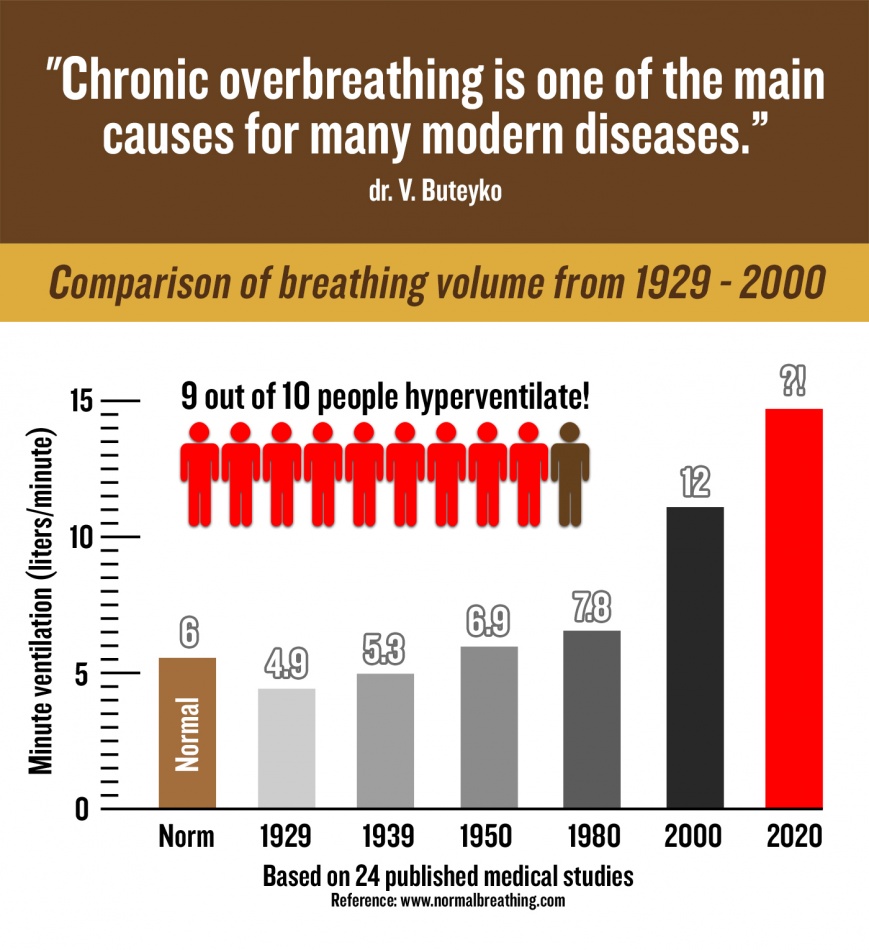We come into this world with the ability to take proper full breaths,
but as we get older we forget how to breathe properly. A host of
challenges go against our breathing: prolonged sitting & slouching,
poor posture, restrictive clothing, bad habits such as smoking, diets
that lead to high blood pressure and racing hearts, increasingly speedy
and emotionally stressful lives, lack of exercise, multitasking,
pollution ...
These are just a few of the things in a modern lifestyle that
deteriorates proper breathing and subsequently proper oxygenation.
Modern
life causes the average person to use about a third of his natural lung
capacity, while producing anywhere from 12 to 18 breaths a minute.
http://nirvana.fitness/-nirvanafitness-explained.html

Only 70-80 years ago, breathing of ordinary people was very different from breathing of modern people. Modern people breathe about 2-3 times more air, twice more than the medical norm.
Over
90% of the modern population have chronic hyperventilation hidden in
the modern lifestyle. The aspects of the modern lifestyle that represent
causes of hyperventilation are: stress, supine sleep, mouth breathing,
exercise with mouth respiration, laziness, overeating, oversleeping,
overheating, slouching, addictions, and many other "innovations" that
intensify basal breathing (or breathing at rest) and decrease
body-oxygen content. (reference: www.normalbreathing.com)
The trouble began with industrialization and ever faster lifestyle.
Up until the past 150 years, our daily activities – farming, hunting ,
hard manual labor – required that we use our diaphragms as our main
breathing muscle.
Now we've become sedentary. We can go days without using our
diaphragms. We've become lazy, sitting in front of computers and using
the weaker intercostal breathing muscles in the rib cage for breaths
that are incomplete but adequate for living."
The diaphragm is the key driver of the respiratory pump with
attachments onto the lower six ribs, xiphoid process of the sternum, and
the lumbar vertebral column (L1‐3). Hodges et al. stated that since the
diaphragm performs both postural and breathing functions, disruption in
one function could negatively affect the other.
While at the same time, thoracic (chest) breathing can have an
acute effect on respiratory chemistry, specifically a decrease in the
level of carbon dioxide (CO2) in the bloodstream. This causes the pH of
the blood to increase, and a state of respiratory alkalosis results.
Respiratory alkalosis can trigger changes in physiological,
psychological, and neuronal states within the body that may negatively
affect health, performance, and the musculoskeletal system.
Ten or fewer deeper, slower breaths per minute is best for overall
health. The main physiological benefit to slower breathing is that it
increases oxygen saturation in cells. This unleashes a cascade of
positive effects, including giving you more energy and increased
cognitive abilities.
Once you go below 10 breaths a minute you start to engage the
parasympathetic nervous system. Slow breathing activates the vagus
nerve, the primary cranial nerve, which is associated with a
recuperative state. Studies have also demonstrated that slow breathing
increases alpha waves in the brain, calming mid-range waves that foster a
relaxed yet alert state of mind.